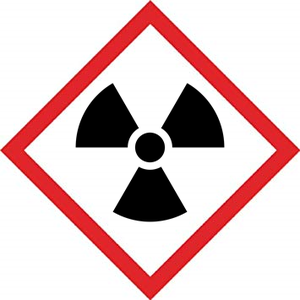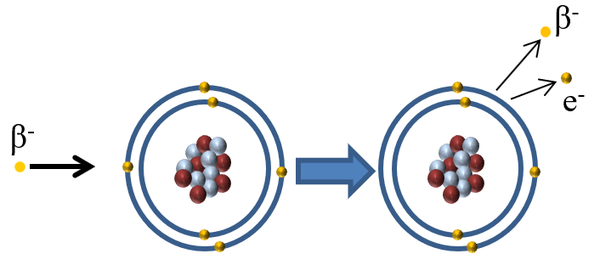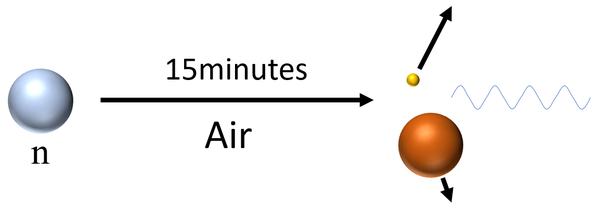Key Stage 3
Meaning

The
hazard symbol for
ionising radiation.
Ionising Radiation is radiation which can cause atoms to lose electrons and become ions.
About Ionising Radiation
- Ionising radiation damages living organisms.
- Ionising radiation may kill cells by damaging the parts inside them, particularly the DNA.
- Ionising radiation can cause the appearance of burns to the skin. A high enough dose of Ionising Radiation can cause instant death.
Precautions
Key Stage 4
Meaning
Ionising Radiation is radiation emitted from the nucleus of an atom which can cause other atoms to lose electrons and become ions.
About Ionising Radiation
- The units of exposure to ionising radiation are the Sievert which is 1 Joule of energy from ionising radiation being absorbed by 1 kilogram of flesh.
In Nuclear Physics there are three types of ionising radiation:
Ionising Atoms
Comparison of Ionising Radiation
Precautions
Ionising Radiation and Cancer
- Exposure to ionising radiation is a risk factor in cancer because ionising radiation can cause DNA molecules to break. When the cell tries to repair the DNA it can make mistakes called mutations. If this mutation tells the cell to replicate constantly then this becomes cancer.
Medical Uses of Ionising Radiation
- Ionising Radiation can be used for both medical imaging and irradiating tumors.
Radioactive Tracers
- Radioactive tracers can be used to image specific glands, organs or trace the flow of fluids through organs.
- Different glands and organs collect different compounds from the blood stream. A compound containing a radioactive isotope can be injected into the blood and this will accumulate in the desired gland or organ. While there the unstable isotopes decay and this can be detected. This can be used to create an image of that gland or organ.
- Fluids in certain organs can become blocked. These blockages can be detected by injecting or ingesting a radioactive isotope which will accumulate at the blockage. This accumulation can then be detected as the unstable isotopes decays to produce ionising radiation.
Irradiating Tumours
- The irradiation of tumours can be done using radioactive isotope.
- Cancer cells are more sensitive to ionising radiation than healthy cells so they can be targeted by a stream of ionising radiation to kill those cells.
- One method to irradiate tumours is to place a pellet of radioactive material into the centre of a tumour. This pellet is encased in a protective layer (to prevent contamination) of other tissues. Once the pellet has destroyed the cancer cells it can be removed.
- Another method is to send multiple beams of ionising radiation from different directions so that they all cross over at the same point in the body (the location of the tumour). Where the beams cross over there will be a very high intensity of ionising radiation which will destroy the tumour.
References
AQA
- Ionising radiation, pages 111, 217, GCSE Physics; Student Book, Collins, AQA
- Ionising radiation, pages 198, 199, 201, 228, GCSE Combined Science; The Revision Guide, CGP, AQA
- Ionising radiation, pages 44-48, 81, GCSE Physics; The Revision Guide, CGP, AQA
- Ionising radiation; alpha, pages 114, 116, 122, GCSE Combined Science Trilogy; Physics, CGP, AQA
- Ionising radiation; alpha, pages 126, 128, 134, GCSE Physics; The Complete 9-1 Course for AQA, CGP, AQA
- Ionising radiation; alpha, pages 198, 199, 201, GCSE Combined Science; The Revision Guide, CGP, AQA
- Ionising radiation; alpha, pages 44, 45, 47, GCSE Physics; The Revision Guide, CGP, AQA
- Ionising radiation; beta, pages 115, 117, 122, GCSE Combined Science Trilogy; Physics, CGP, AQA
- Ionising radiation; beta, pages 127, 129, 134, GCSE Physics; The Complete 9-1 Course for AQA, CGP, AQA
- Ionising radiation; beta, pages 198, 199, 201, GCSE Combined Science; The Revision Guide, CGP, AQA
- Ionising radiation; beta, pages 44, 45, 47, 48, GCSE Physics; The Revision Guide, CGP, AQA
- Ionising radiation; dangers, page 137, GCSE Physics; The Complete 9-1 Course for AQA, CGP, AQA
- Ionising radiation; dangers, pages 201, 228, GCSE Combined Science; The Revision Guide, CGP, AQA
- Ionising radiation; dangers, pages 47, 48, 81, GCSE Physics; The Revision Guide, CGP, AQA
- Ionising radiation; gamma, pages 115, 122, GCSE Combined Science Trilogy; Physics, CGP, AQA
- Ionising radiation; gamma, pages 127, 134, GCSE Physics; The Complete 9-1 Course for AQA, CGP, AQA
- Ionising radiation; gamma, pages 198, 199, 201, 223, 225, GCSE Combined Science; The Revision Guide, CGP, AQA
- Ionising radiation; gamma, pages 44, 45, 47-49, GCSE Physics; The Revision Guide, CGP, AQA
- Ionising radiation; uses, pages 138, 139, GCSE Physics; The Complete 9-1 Course for AQA, CGP, AQA
- Ionising radiation; uses, pages 48, 80, GCSE Physics; The Revision Guide, CGP, AQA
Edexcel
- Ionising radiation, pages 136, 156, 157, GCSE Physics, CGP, Edexcel
- Ionising radiation, pages 168, 174-177, GCSE Combined Science; The Revision Guide, CGP, Edexcel
- Ionising radiation, pages 359, 363, GCSE Combined Science, Pearson Edexcel
- Ionising radiation, pages 43, 51-56, GCSE Physics; The Revision Guide, CGP, Edexcel
- Ionising radiation, pages 95, 99, GCSE Physics, Pearson Edexcel
- Ionising radiation; uses, pages 134, 135, 168-172, GCSE Physics, CGP, Edexcel
OCR
- Ionising radiation, pages 192, 200, Gateway GCSE Combined Science; The Revision Guide, CGP, OCR
- Ionising radiations, pages 173, Gateway GCSE Physics, Oxford, OCR





